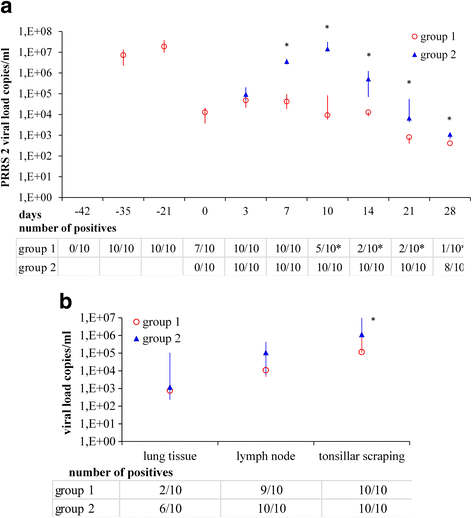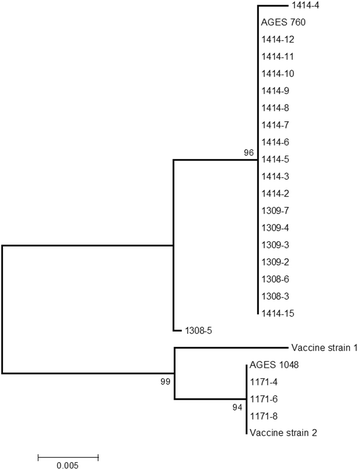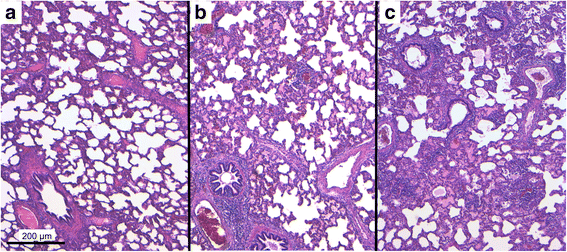Efficacy of live attenuated porcine reproductive and respiratory syndrome virus 2 strains to protect pigs from challenge with a heterologous Vietnamese PRRSV 2 field strain
- PMID: 29673363
- PMCID: PMC5907707
- DOI: 10.1186/s12917-018-1451-y
Efficacy of live attenuated porcine reproductive and respiratory syndrome virus 2 strains to protect pigs from challenge with a heterologous Vietnamese PRRSV 2 field strain
Abstract
Background: Effective vaccines against porcine reproductive and respiratory syndrome virus (PRRSV), especially against highly pathogenic (HP) PRRSV are still missing. The objective of this study was to evaluate the protective efficacy of an experimental live attenuated PRRSV 2 vaccine, composed of two strains, against heterologous challenge with a Vietnamese HP PRRSV 2 field strain. For this reason, 20 PRRSV negative piglets were divided into two groups. The pigs of group 1 were vaccinated with the experimental vaccine, group 2 remained unvaccinated. All study piglets received an intranasal challenge of the HP PRRSV 2 on day 0 of the study (42 days after vaccination). Blood samples were taken on days 7 and 21 after vaccination and on several days after challenge. On day 28 after challenge, all piglets were euthanized and pathologically examined.
Results: On days 7 and 21 after vaccination, a PRRSV 2 viraemia was seen in all piglets of group 1 which remained detectable in seven piglets up to 42 days after vaccination. On day 3 after challenge, all piglets from both groups were positive in PRRSV 2 RT-qPCR. From day 7 onwards, viral load and number of PRRSV 2 positive pigs were lower in group 1 than in group 2. All pigs of group 1 seroconverted after PRRSV 2 vaccination. PRRSV antibodies were detected in serum of all study pigs from both groups from day 14 after challenge onwards. In group 2, moderate respiratory symptoms with occasional coughing were seen following the challenge with HP PRRSV 2. Pigs of group 1 remained clinically unaffected. Interstitial pneumonia was found in four piglets of group 1 and in all ten piglets of group 2. Histopathological findings were more severe in group 2.
Conclusions: It was thus concluded that the used PRRSV 2 live experimental vaccine provided protection from clinical disease and marked reduction of histopathological findings and viral load in pigs challenged with a Vietnamese HP PRRSV 2 field strain.
Keywords: Efficacy; HP PRRSV 2; Immune response; Vaccine; Viral replication.
Conflict of interest statement
Ethics approval and consent to participate
Housing, animal care and experimental protocol (notification number LF1-TVG-26/022–2014) were approved by the local ethics committee (Agency of the Government in Lower Austria, Department of Agrarian Law). The study piglets were bought by the Austrian Agency for Health and Food Safety for conduction of the study. Consent was given from the original owner of the pigs to conduct the study and take samples.
Competing interests
The authors declare that they have no competing interest.
Publisher’s Note
Springer Nature remains neutral with regard to jurisdictional claims in published maps and institutional affiliations.
Figures




Similar articles
-
Comparison of two genetically distant type 2 porcine reproductive and respiratory syndrome virus (PRRSV) modified live vaccines against Vietnamese highly pathogenic PRRSV.Vet Microbiol. 2015 Sep 30;179(3-4):233-41. doi: 10.1016/j.vetmic.2015.06.013. Epub 2015 Jun 26. Vet Microbiol. 2015. PMID: 26149103 Clinical Trial.
-
Ability of ELISAs to detect antibodies against porcine respiratory and reproductive syndrome virus in serum of pigs after inactivated vaccination and subsequent challenge.BMC Vet Res. 2016 Nov 21;12(1):259. doi: 10.1186/s12917-016-0888-0. BMC Vet Res. 2016. PMID: 27871292 Free PMC article.
-
Assessment of the safety and efficacy of an attenuated live vaccine based on highly pathogenic porcine reproductive and respiratory syndrome virus.Clin Vaccine Immunol. 2015 May;22(5):493-502. doi: 10.1128/CVI.00722-14. Epub 2015 Mar 4. Clin Vaccine Immunol. 2015. PMID: 25739919 Free PMC article.
-
Live porcine reproductive and respiratory syndrome virus vaccines: Current status and future direction.Vaccine. 2015 Aug 7;33(33):4069-80. doi: 10.1016/j.vaccine.2015.06.092. Epub 2015 Jul 4. Vaccine. 2015. PMID: 26148878 Review.
-
Porcine reproductive and respiratory syndrome virus vaccines: current status and strategies to a universal vaccine.Transbound Emerg Dis. 2014 Apr;61(2):109-20. doi: 10.1111/tbed.12016. Epub 2013 Jan 24. Transbound Emerg Dis. 2014. PMID: 23343057 Review.
Cited by
-
Simultaneous Infection With Porcine Reproductive and Respiratory Syndrome and Influenza Viruses Abrogates Clinical Protection Induced by Live Attenuated Porcine Reproductive and Respiratory Syndrome Vaccination.Front Immunol. 2021 Nov 11;12:758368. doi: 10.3389/fimmu.2021.758368. eCollection 2021. Front Immunol. 2021. PMID: 34858411 Free PMC article.
-
Molecular characterization of the RNA-protein complex directing -2/-1 programmed ribosomal frameshifting during arterivirus replicase expression.J Biol Chem. 2020 Dec 25;295(52):17904-17921. doi: 10.1074/jbc.RA120.016105. Epub 2020 Oct 30. J Biol Chem. 2020. PMID: 33127640 Free PMC article.
-
Genetic evolution and alterations in pathogenicity of highly pathogenic porcine reproductive and respiratory syndrome virus.Virulence. 2025 Dec;16(1):2504124. doi: 10.1080/21505594.2025.2504124. Epub 2025 May 22. Virulence. 2025. PMID: 40401680 Free PMC article.
References
-
- Wensvoort G. Lelystad virus and the porcine epidemic abortion and respiratory syndrome. Vet Res. 1993;24:117–124. - PubMed
MeSH terms
Substances
LinkOut - more resources
Full Text Sources
Other Literature Sources
Research Materials
Miscellaneous

